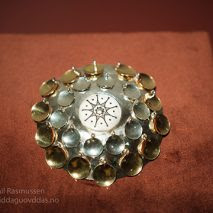The Duodji Reader is a new publication from the Sámi publisher Davvi Girji in Karasjok, Norway. Edited and with an introduction by Harald Gaski and Gunvor Guttorm, the twelve essays circle around the subject of Sámi artisanship, generally from a historical and theoretical perspective. The large, handsomely designed paperback is bilingual—North Sámi and English—and includes essays by several key duojárs or artisans from the past and by contemporary scholars and curators, as well as color photographs of modern-day duodji.
Duodji (pronounced something like “dwotchi” though I’ve also heard it as “dwodji” and “dwerchi”) is usually translated as handicraft. The making of Sami objects for domestic use, everything from ceremonial drums, sleds and skis, clothing and shoes of fur and fabric, milking bowls, decorated spoons, knives with etched sheaths of bone, root baskets, bentwood chests, toys and tools, has been part of Sámi culture for many hundreds of years. Duodji was described and collected as early as the 1600s by such scholars as Johannes Schefferus. Tourists bought duodji from Sámi individuals and curio shops in the 1800s. Nordic museums amassed piles of Sámi handiwork through the 1900s, cataloguing the objects variously as ethnographic and artistic.
 |
| Per Thomas Aira Balto: from Duodji Reader |
Although the editors of this Duodji Reader peg the revitalization of duodji to the 1970s in their introduction, it’s been my impression that renewed interest in duodji was already stirring in the 1930s and 1940s, when a variety of Sámi artisans and educators like Karin Stenberg and Gustav Park in Sweden saw passing on artisanal skills to a younger generation as an important step to conserving the past and creating a new political and cultural future.
Offering classes in duodji in Sámi schools often went hand in hand with teaching language. Soon after WWII, a folk high school in Jokkmokk grew into an institution. The Sámi Training Center (Sámij åhpadusguovdásj) today teaches a wide range of classes in duodji, along with reindeer herding, food preparation, and the Lule Sámi language. The school’s students display their craftsmanship at the well-known Winter Market in Jokkmokk and some settle in the community to continue to make and sell their work. Sámi Allaskulva/Sámi University of AppliedSciences in Kautokeino, Norway is another important teaching institution where students learn North Sámi and can study duodji. Editor Gunvor Guttorm, who teaches there, is the first professor of duodji with a doctorate; she has written extensively on the topic of duodji as a component of Sami education.
The Duodji Reader, with previously published contributions from the 1960s by duojárs and artists Lars Pirak from Jokkmokk and Iver Jåks from Karasjok, along with a number of pieces from the past ten years, is a rich source of texts about duodji as personal expression and process. The theoretical contributions, such Harald Gaski’s essay on Indigenous aesthetics, makes an attempt to articulate a larger epistemological perspective, as does “Meaning of Sámi Culture in the Brand Building of Dudoji” by Sigga Marja Magga. Other essays explore particular objects, winter clothing or the milking bowl. Maja Dunfjeld, in “Form and Content in South Sámi Ornamentation,” writes about Traditional Knowledge and explores some of her family history in South Sápmi, and how that shapes her work as an artisan and lecturer on duodji (or duedtie as it is written in the South Sámi language). I found this piece particularly insightful on the subject of how skills are transmitted both technically and orally.
I also enjoyed “A Conversation with Perisak Juuso,” in which the author Irene Snarby and her husband make a visit from their home in Tromsø to the workshop of Juuso in Northern Sweden. Juuso discusses with them his different projects and the natural materials he uses, as well as his family background and how he came to duodji.
 |
| Petteri Laiti at SDG |
The liveliness of this encounter with a working duojár made me wish there had been more interviews with contemporary duojárs and artists who use craft techniques long-established in Sápmi to make traditional objects as well as innovative new work. I’m thinking of someone like Petteri Laiti from Finland, a pioneer in the field, who works with reindeer horn and skin, as well as silver, gold, and wood. He began to work with duodji in the 1960s, later studied in Jokkmokk and attended goldsmith school in Finland. His work is highly valued and often exhibited, and there are many others who might well have been profiled to give a more well-rounded sense of what a meaningful career in duodji looks like.
Likewise, in her article “An Absence of Women’s Duodji and Duddjon, “ Gunvor Guttorm, herself a fine duojár, discusses a long-standing preference on the part of collectors for crafts, including knives and engraved spoons, made by men. It would have helpful to balance that critique by including essays or interviews with some of the very well-known Sámi women duojárs and artists whose work is informed by duodji, such Britta Marakatt-Labba, Rose-Marie Huuva, and Outi Pieski, and whose objects and installations are intimately influenced by traditional female practices of needlecraft and leatherwork, as well as making use of wood, metal, bone materials and techniques more generally associated with male duojárs.
But these notes and suggestions aside, Duodji Reader is a fascinating and necessary compendium of older and newer writings in one book, about an increasingly important topic for anyone interested in Sámi culture past and present.
The Duodji Reader is jointly sponsored by Sami Allaskulva and Norwegian Crafts, which has some photographs and supplementary material about the book and contributors on its website.
A panel featuring Harald Gaski and Gunvor Guttorm is available on YouTube from Scandinavia House.
